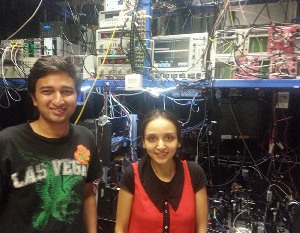Dec 3 2013
Quantum technologies for communication and computation can play on the strengths of different systems: photons are good for zipping information around, atoms are good for storage. CQT researchers have demonstrated a technique for producing entangled photon pairs that promises to help interface the two.
 PhD students Bharath (left) and Gurpreet (right) assembled the kit behind them to produce pairs of entangled photons that are well-suited to interfacing with atoms for quantum communcation schemes.
PhD students Bharath (left) and Gurpreet (right) assembled the kit behind them to produce pairs of entangled photons that are well-suited to interfacing with atoms for quantum communcation schemes.
The work was published in October in Physical Review Letters, where the paper was highlighted as an Editor's Suggestion. It was also featured in the magazine Physics.
For the paper's first authors Bharath Srivathsan and Gurpreet Kaur Gulati (pictured), the paper represents the culmination of four years' work in CQT's PhD programme. They built from scratch the experiment to produce photon pairs through four-wave mixing in a cold atomic vapour, with help from various members of Christian Kurtsiefer's group. The effort is paying off, with other results in the pipeline too. "It's an exciting time," says Bharath.
Entangled pairs
Many schemes for quantum information processing rely on pairs of entangled photons &endash; photons that share a quantum state so that their properties are correlated across space. Researchers routinely produce such photons through a process known as spontaneous parametric down conversion: they shine a laser on a crystal that splits high-energy photons into two low-energy ones. These lower energy pairs emerge entangled.
However, photons produced by this method emerge with a wide range of frequencies, which is not ideal when it comes to interfacing with atoms. Atoms absorb photons with particular frequencies matched to transitions in their energy levels. The ideal photon source for talking to atoms therefore produces pairs with a well-defined, narrow range of frequencies.
That's just what Bharath, Gurpreet and their colleagues have made. The technique of four-wave mixing in a cold atomic vapour uses lasers at one set of frequencies to excite cold Rubidium atoms, which then de-excite in a two-step process that produces two entangled photons. These photons are correlated in time and frequency and emerge in one direction, making it easy to collect them into an optical fibre.
The CQT researchers found the source produces 7700 pairs of photons per second with a frequency spread of only 30MHz. This compares to a frequency width of 0.1THz or more for photons from downconversion in crystals, a 10,000-fold improvement. Although other groups have built similar sources, they have not produced such a high rate of photons. The CQT team are also the first to measure the bandwidth directly.
On the bright and narrow
"The narrow bandwidth and brightness of our source makes it ideal for interacting with atomic ensembles in quantum communication protocols" the authors state. Protocols may either make use of both photons in the pair, or use one photon as a signal or 'herald' that the other is about to arrive.
One thing that excites the CQT team is the observation that their photons are coming out with the right kind of 'shape' to interact efficiently with atoms. The shape of a photon is measured by its intensity profile over time. The photons from this source show an exponentially rising profile that should make it easier for them to excite an atom.
As a follow-up to the published work, the CQT team are trying to establish quantum interference between an entangled photon from this source and a photon emitted by a single Rubidium atom. This is a step towards making the photon interact directly with the atom.
For more details, see "Narrow Band Source of Transform-Limited Photon Pairs via Four-Wave Mixing in a Cold Atomic Ensemble", Bharath Srivathsan, Gurpreet Kaur Gulati, Brenda Chng, Gleb Maslennikov, Dzmitry Matsukevich, and Christian Kurtsiefer, Phys. Rev. Lett. 111, 123602 (2013); arXiv: 1302.3706.